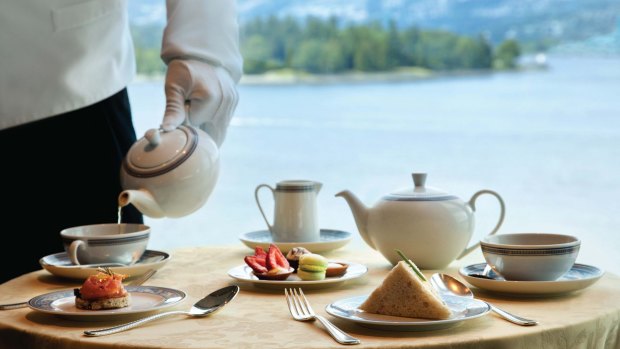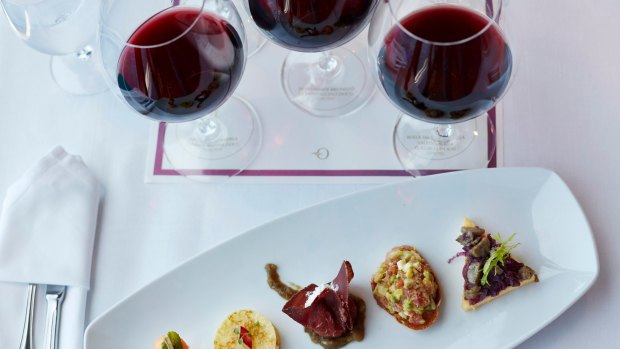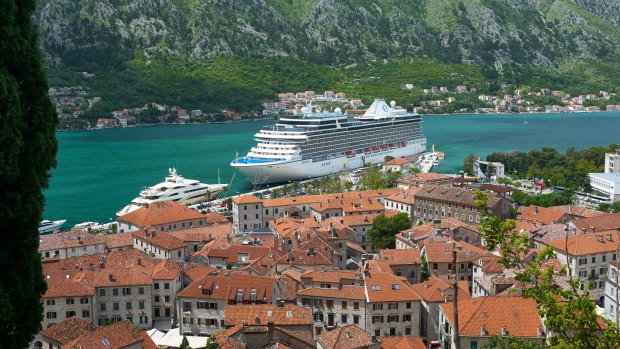This was published 6 years ago
Cruising Europe: Gourmet food and wine, beautiful cities, precious memories
By Jill Dupleix

A cruise is an opportunity to relax and enjoy the details.Credit: Oceania Cruises
As Barbra Streisand would have it, memories are just scattered pictures that light the corners of your mind. They don't present themselves neatly, arranged as chronologically and as geo-tagged as the images on your smartphone.
The memories of a cruise can be particularly random; scattered pictures that pop up months later and make me smile as I'm stopped at a traffic light. It's not the ship's tonnage I remember, or the cost of the shore excursions, or how many bread rolls the chefs have to bake to feed its 2300 passengers.
It's the chat with a shopkeeper about a local cheese bought for a picnic in a rundown food store in Malaga, the chance meeting of friends in far-from-home Kotor, the smiles of young cabin attendants from Athens, Belize and Senegal, and the giggly excitement of cruising into Monte Carlo at dawn, like a cat burglar casing the joint.

Memories of good food and wine are all part of the pleasure.Credit: Josh Lewis
It's as if my brain is sending me postcards from my own holiday.
This happy side-effect doesn't happen so much after those arduous fly-in, fly-around, fly-out trips that Australians are forced to do. You know what we're like. "We'll be in Paris anyway, so we may as well fly to Helsinki, Athens and Edinburgh as well, while we're over there. We have a whole week, after all." The reality is a blur of taxis, buses, aeroplanes, airports, subways, hotel check-ins and check-outs.
The real reason I'm a cruise convert is because I've done too many of those FIFO trips to Europe and America. They are fun, exciting and adrenalin-filled, but they aren't relaxing. And most of us have the sort of brain that needs to be relaxed in order for things to stick. Brains are smart, after all. Clearly, if you're only passing through in a rush, whatever happens is not worth archiving.

Oceania Riviera sailing into Kotor.
On a cruise, however, you create your own rhythm and your own pace. The ship becomes a home that you return to every evening, giving the brain time to take everything in, digest it overnight, and retain it. Take my last cruise, on the majestic Oceania Riviera, moving from the well-worn sea lanes of the Western Mediterranean around the boot of Italy and up the Adriatic Coast to Venice, mooring at tiny fishing villages in Spain and medieval walled towns in Slovenia. Sister to the much-loved Marina, it's an intimate and sophisticated ship of 1250 guests, with luxurious staterooms and a genuine emphasis on good food and culinary adventures. Over 11 days and nights, I managed to do and see so much, it was fun, exciting and adrenalin-filled. But it was also relaxing, so I actually remember it all.
Back home again, I can just put the memories on shuffle as I chop pumpkin, water the herbs or make the bed.
Click. I'm leaning over the balcony of my stateroom. It's eerily silent but for the hum of the engine as we glide slowly into a new port of call at dawn. Most people miss these moments of arrival, being too engrossed in the croissants or eggs and bacon. But to arrive at a port in the same manner as ships always have, for centuries – slowly, warily, before daylight – is magical. In most Mediterranean ports, you can see the ancient forts and lookouts on the hills. You can smell the land. And there is always – always - a single fisherman in a small boat. Perhaps he's the same one.
Click. Shoes clatter on cobblestones as day-trippers stroll through the medieval arched stone entrance to the ancient walled city of Dubrovnik. That it exists at all is something of a miracle after the heavy bombing of the 1991 Croatia/Yugoslav war. Today, it's a walled city of ice-creams and Serbian barbecues, art galleries and lacemakers. There are new fears that the new invaders, over a million credit-card carrying tourists a year, could be as destructive a force, vastly out-numbering the 3000 residents. Yet it seems to swallow them all up, feed them sausages and beer, and send them laughing on their way again. I have a strong image of Robert, our tour guide, a scholarly, humble man, as he leaned back against the warm stone of his own walled garden in the centre of the city. He wanted us to know he was grateful for the tourism, rather than resentful. "Dubrovnik was a princess who went to sleep and was awakened by the kiss of a prince," he said. "That prince was tourism."
Click. Two women at the next table in the Grand Dining Room are revelling in the multi-course dinner under the luminous crystal chandelier, giggling as they order all the sides. What brought them on the cruise, I asked. They have been friends for over 40 years, since school. My friend lost her husband eight months ago, says one. So she talked me into booking a cruise together, adds the other. They fall silent. We clink glasses and raise a toast to good friends.
Click. A long, narrow wine cellar in Palermo. No tourist tat, just wooden barrels and shelves of wine that I gradually realise is 100 per cent Sicilian. Nothing foreign, like, from Tuscany. While Oceania offers all manner of wine and drinks packages, it also – unlike several cruise lines – allows its guests to BYO. We talk with the owner, he offers a taste. We choose the wine we'll drink with dinner on board as we sail away.
Click. The elevators of the Oceania Riviera act as cones of silence: everyone who enters feels free to share exactly what they think – of breakfast, of the pool, of yesterday's port – without fear of retribution; it's a place for swapping on-board tips and cracking jokes, of making light of bad weather or clinking glasses in celebration (yes, people actually wander around with flutes of champagne in hand).
Click. The eyes of Sainte Lucie are staring at me. There is always a small table of them for sale – €2 each – at the Vieux Port in Marseille, brought up in the nets with the local catch. These small whorled orange ovals are the operculum, or cap, of the rough turban sea snail found in the Mediterranean. Legend has it that poor Lucie plucked out her eyes and threw them into the sea as an offering to save her sick mother, and locals have long believed her eyes ward off evil. It's true. I bought one 20 years ago from a man with sky-blue eyes and skin like a brown leather armchair, walked up the hill into a little jeweller and had it clasped in gold and hung on a chain, and have avoided evil ever since.
Click. The Mistral, that strong, dry north-westerly that sweeps through the Rhone Valley to the sea at speeds of up to 100 kilometres an hour, begins the day we are in port, in Marseille. Suddenly the warm, sunny morning turns into something malevolent, whipping up papers, pushing cafe chairs along the street, slapping your arm into your face. Tourists squeal, nearly fall and run to shelter. The locals just brace themselves, dig hands into pockets and soldier on.
Click. A kitchen tour with senior executive chef Laurent Trias from Bordeaux becomes a story of passion, disillusionment, and re-engagement. After 10 years of cruising, he says, he was beginning to hate it. "It just became a numbers game, getting bigger and bigger," he says. "The quality suffered." Then Oceania changed the game. "They built separate kitchens for each specialty restaurant rather than have all the food come from the once large central kitchen. Each restaurant has its own head chef. It changed everything."
Click. The Church of Our Lady is one of three baroque churches in the sleepy little village of Prcanj, on the dramatically long and narrow Bay of Kotor in Montenegro. Three young girls stand in front of us playing Mozart, Vivaldi and Dvorzak on their flutes, then bow and slip away. We gather over sweet, yeasty doughnuts and glasses of home-made vocna rakija breska (peach brandy) outside, under the peach trees, reflecting, not for the first time, what a privilege it is to travel.
Click. Every night is date night on board. But one night was different. We didn't want cocktails and caviar, or contemporary Asian with choose-your-own chopsticks, or even the Spanish suckling pig on the buffet. We wanted roast chicken dinner. You know, like at home. So we booked a linen-clothed table for two in Jacques' restaurant, ordered the famous American chef's roast chicken for two, put a Caesar salad in the middle of the table, and asked for two glasses of Monterey Pinot Noir.
The white-jacketed staff were horrified. No starter? No appetiser? No sides? No Super Tuscan wine for €250? They couldn't cope with the fact that we didn't want anything else. We had to share a cheese platter, just to make them feel better. It was a great night.
Slow travel, like slow food, allows us to feast on the small details we would otherwise have rushed past in our busyness. It makes connections that help us see similarities rather than differences. It's about travelling more as a flaneur, a wanderer delighted by what Honore de Balzac called the "gastronomy of the eye". It helps us "be" where we are, allowing the power of a random brief experience to elevate us – and stay in our minds. But ultimately, as Barb says, it's the laughter, we will remember.
Jill Dupleix travelled as a guest of Oceania Cruises.
MORE
See www.traveller.com.au/europe
See www.traveller.com.au/cruises
CRUISE
Jill Dupleix travelled on the Oceania Riviera from Barcelona to Venice. A similar cruise is offered from November 1 to 13 on the Riviera from Venice to Barcelona, from $3160 per person. Phone 1300 355 200 or see www.oceaniacruises.com.
Sign up for the Traveller Deals newsletter
Get exclusive travel deals delivered straight to your inbox. Sign up now.